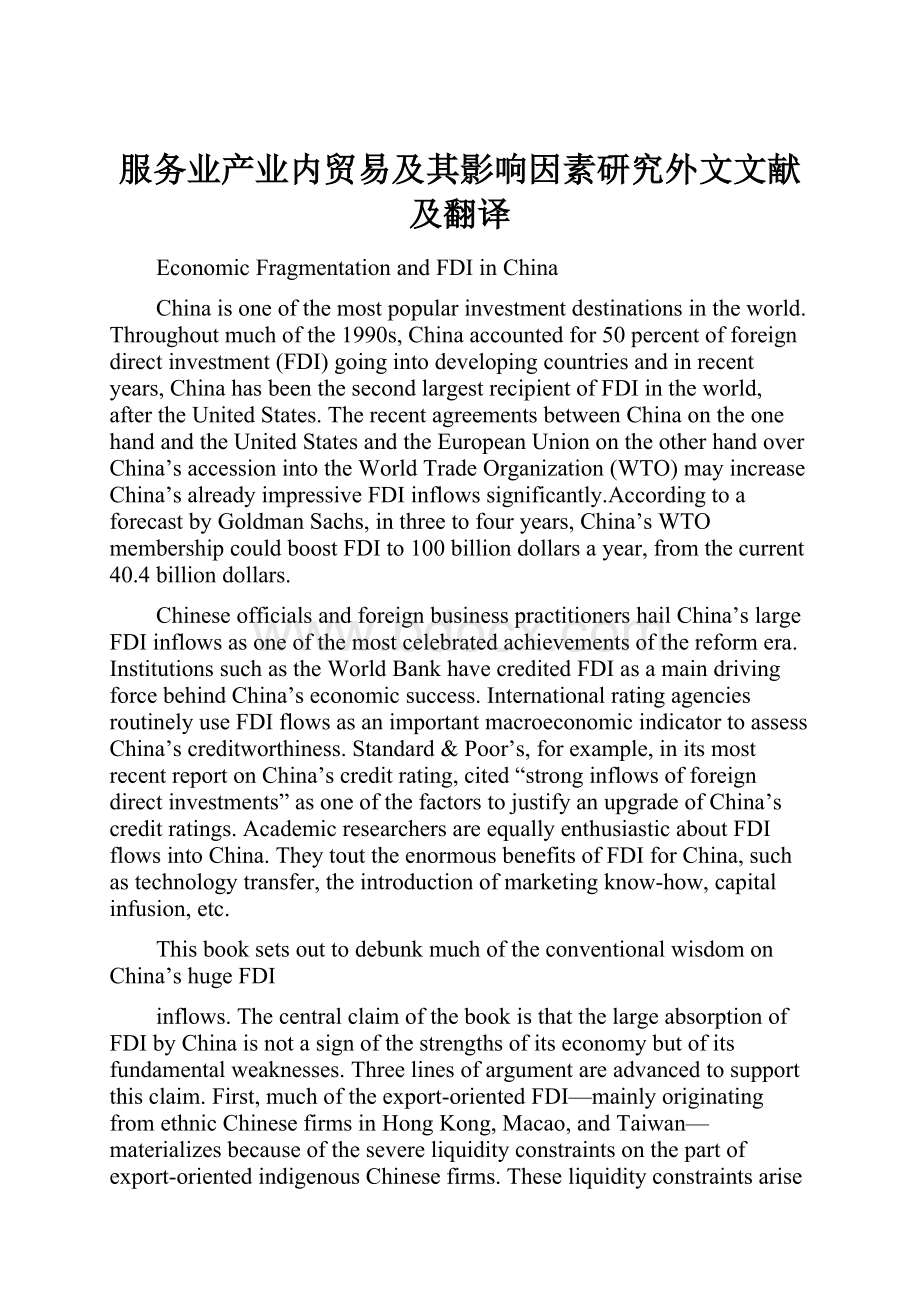服务业产业内贸易及其影响因素研究外文文献及翻译.docx
《服务业产业内贸易及其影响因素研究外文文献及翻译.docx》由会员分享,可在线阅读,更多相关《服务业产业内贸易及其影响因素研究外文文献及翻译.docx(9页珍藏版)》请在冰豆网上搜索。

服务业产业内贸易及其影响因素研究外文文献及翻译
EconomicFragmentationandFDIinChina
Chinaisoneofthemostpopularinvestmentdestinationsintheworld.Throughoutmuchofthe1990s,Chinaaccountedfor50percentofforeigndirectinvestment(FDI)goingintodevelopingcountriesandinrecentyears,ChinahasbeenthesecondlargestrecipientofFDIintheworld,aftertheUnitedStates.TherecentagreementsbetweenChinaontheonehandandtheUnitedStatesandtheEuropeanUnionontheotherhandoverChina’saccessionintotheWorldTradeOrganization(WTO)mayincreaseChina’salreadyimpressiveFDIinflowssignificantly.AccordingtoaforecastbyGoldmanSachs,inthreetofouryears,China’sWTOmembershipcouldboostFDIto100billiondollarsayear,fromthecurrent40.4billiondollars.
ChineseofficialsandforeignbusinesspractitionershailChina’slargeFDIinflowsasoneofthemostcelebratedachievementsofthereformera.InstitutionssuchastheWorldBankhavecreditedFDIasamaindrivingforcebehindChina’seconomicsuccess.InternationalratingagenciesroutinelyuseFDIflowsasanimportantmacroeconomicindicatortoassessChina’screditworthiness.Standard&Poor’s,forexample,initsmostrecentreportonChina’screditrating,cited“stronginflowsofforeigndirectinvestments”asoneofthefactorstojustifyanupgradeofChina’screditratings.AcademicresearchersareequallyenthusiasticaboutFDIflowsintoChina.TheytouttheenormousbenefitsofFDIforChina,suchastechnologytransfer,theintroductionofmarketingknow-how,capitalinfusion,etc.
ThisbooksetsouttodebunkmuchoftheconventionalwisdomonChina’shugeFDI
inflows.ThecentralclaimofthebookisthatthelargeabsorptionofFDIbyChinaisnotasignofthestrengthsofitseconomybutofitsfundamentalweaknesses.Threelinesofargumentareadvancedtosupportthisclaim.First,muchoftheexport-orientedFDI—mainlyoriginatingfromethnicChinesefirmsinHongKong,Macao,andTaiwan—materializesbecauseofthesevereliquidityconstraintsonthepartofexport-orientedindigenousChinesefirms.Theseliquidityconstraintsarisenotbecauseexport-orientedChinesefirmsareinefficientbutbecausetheyareprivateandforyearsChinesebankswereexplicitlyprohibitedfromlendingtoprivatefirms.Privatefirmshavenochoicebuttoraisefinancingintheonlywaytheycan—sellingtheirclaimsonfuturecashflowstoforeignfirms.FDIrisesasaresult.
Second,muchoftheFDIorientedtowardthedomesticmarket—mainlyincapital-intensiveindustries—doesnotfinancethecreationofnewcapacitybutfinancestheacquisitionofexistingassets,mainlyfromstate-ownedenterprises(SOEs).SOEshaveaccumulatedmassivefinanciallossesandhugeliabilitiesontheirbalancesheets.TheinsolvencyofSOEsisafamiliarstory.WhatisnotfamiliaristhefactthatSOEshavebuiltupapotentiallyvaluableassetbaseduringthereformera,whichwasfinancedbyagenerousinfusionofsubsidizedcreditfromthebankingsystem.Ontopofagoodassetbase,SOEshavegeneratedpoorornegativereturns,whichrendersthempotentialacquisitiontargets.BecausetheChinesegovernmentstillrefusestoadoptaprivatizationpolicytodealwiththeSOEinsolvencysituation,theonlyviableacquirersendupbeingforeignfirms.FDIrisesonthisaccount.Third,China’scapitalandproductmarketsareseverelyfragmented,whichmeansthataChinesefirmlocatedinProvinceAcannotinvestinProvinceB.Theeconomicfragmentationgivesanenormousadvantagetoforeignfirms,whicharenotfacedbysimilarcapitalconstraints.FDIrisesonthisaccountbecauseforeignfirmscanchoosemoreprojectstoinvestinthandomesticfirms.Inbrief,FDIinflowsriseinresponsetoeithermarketgrowthopportunitiesortolabor-costsavingopportunitiesonlybecauseindigenousfirmsareuncompetitiveacross-the-boardandareunabletorespondtothesamesetofopportunities.
Anumberofaspectsoftheresearchsetthisprojectapartfromothers.Oneisthatanexplicittheoreticalframeworkguidesmuchoftheempiricalresearch.Thebookofferswhatistermedasan“institutionalfoundation”perspectiveonFDI.TheinstitutionalfoundationargumentbothbuildsuponanddepartsfromthedominanttheoreticalapproachinthestudiesofFDI,whichisknownastheindustrialorganizationtheoryofFDI.ThecommonalityisamicroeconomicreasoningthatFDI,asanownershiparrangement,isdesignedtoovercomecertainproblemsinherentinarms-lengthcontractualtransactions.Thedeparturehastodowithwhatconstitutesthesourcesofproblemsbesettingcontractualtransactions.Whiletheindustrialorganizationtheoryfocusesonmarketfailuresinvolvedintransactionsofcertainresourcesendowedwithuniquecharacteristics(suchasindivisibilityorasset-specificity),theinstitutionalfoundationargumentfocusesonthefailuresresultingfromimperfectly-designedfinancialandeconomicinstitutionsinallocatingallgoodsandresources.Furthermore,thesefailuresarenotaresultofcharacteristicsofgoodsorresourcesbeingtransactedbutasaresultofdeliberatepolicyandpoliticalchoicesofthegovernment.
Theseconddeparturedirectlyfollowsfromthefirst.WhilemuchoftheworksonFDIstudiesthemotivationsandcapabilitiesofforeigninvestingfirms,thisstudytriestounderstandthemotivations,constraintsandcapabilitiesoftheChinesehostfirmsandlocalgovernments.TheempiricalemphasisisbasedonaconceptualizationofFDIthatviewsFDIasafunctionofrelative,ratherthanasabsolute,competitivenessofforeignfirms.Relativeforeigncompetitivenessis,inturn,afunctionofforeigncompetitivenessanddomesticuncompetitiveness.Assuch,studyingdomesticuncompetitivenessshouldbejustasanalyticallyrewardingasstudyingforeigncompetitiveness.ThiswayofresearchingFDIhasbeensurprisinglyrareamongexistingstudies.
AlthoughtheoverallobjectiveistoexplainFDIpatternsinChina,theanalyticalframeworkofthebookrevolvesaroundthedesignandoperationsofkeyeconomicandfinancialinstitutionsinChinainaffectingChina’sFDIpatterns.Assuch,thebookoffersabroadre-interpretationnotonlyofFDIinChinabutalsooftheChineseeconomicreforms.ThislatteraspectofthebookshouldinterestthosereaderswhoareinterestedinChina’sreformprocessandinthelessonsonecandrawfromtheChinesereformsrelevanttootherreformingsocialisteconomies.Inrecentyears,theChinesegradualistreformstrategyhasbeenheldupasamodelforcountriestryingtotransformthemselvesintomarketeconomies.Thisbookquestionsthisperspective.Itshowsthatthepartialreforms,whilesuccessfulinincreasingthescopeofmarket,havesofarfailedtoaddressthefundamentalinefficienciesintheChineseeconomyandonereasonwhyChinahasavertedaneconomicmeltdownisbecauseofthelargeinfusionsofFDIratherthanbecauseofthesuccessofChina’sreformstrategy.
Inthisworkingpaper,IonlyfocusononeoftheinstitutionalpillarsunderlyingmuchoftheFDIdevelopmentsinthe1990s.ThispaperfirstdescribesthefragmentationoftheChineseeconomy.EconomicfragmentationhasastrongbearingonChineseFDIdemand.ItreducesthesetofinvestmentopportunitiesavailabletoChinesefirms,whileincreasingthesetofinvestmentopportunitiesavailabletoforeignfirms.FDIrisesbecauseforeignfirmsaremoresuccessfulthanChinesefirmsincapturingtheseinvestmentopportunities.Thepaperpresentsbothquantitativeandcase-studyevidencetodocumentthisphenomenon.
MNCsarenotonlymultinational;theyare,firstandforemost,multi-regionalinChina.Motorola,Schindler,Otis,Volkswagen,Ford,Nabisco,etc.haveallestablishedoperationsacrossthecountryandincreasinglyWesternMNCsarecreatingaholdingcompanystructuretocoordinatetheircomplexactivitiesandinteractionsamongtheirsubsidiariesoraffiliatesandtoeconomizeonthesharedoverheadcosts.Thesecross-regionalinvestmentsoracquisitionsarenotlimitedtotheFortune500corporations;infactmuchsmallerMNCshaveactivelyacquiredassetsthroughoutthecountry.AprominentexampleistheHongKongbasedChinaStrategicInvestmentLtd.ChinaStrategicInvestment,withsalerevenueofonly84milliondollarsin1992,acquired200companiesthroughoutChinaduringaspanoftwoyearsbetween1992and1994.ItsjointventuresarelocatedinmorethannineprovincesanditsChinaTiresHoldings,viaitsacquisitionsoftireplantsinfiveprovinces,emergedtobethelargesttireproducerinChinain1994.CSIwaspoisedtobecomeoneofthelargestindustrialconglomeratesinChinauntilthecentralgovernmentintervenedtoputabrakeonitsacquisitionbidsin1995.
Ourquestion,asalways,is,“Whycan’tChinesecompaniesdothesame?
”WealreadyprovidedoneanswerinChapter2andChapter3:
BecausethegovernmenthasrefusedtoallowSOEstobeprivatized,Chinesenon-statefirmscannotacquireloss-makingSOEswhileMNCscanviawhatIcalla“JVacquisition”mechanism.ButclearlythisisnotthewholeanswerbecauseChineseSOEsdonotacquireotherSOEseither.SOEacquisitionbyotherSOEsclearlydoesnotentailanyideologicalcomplicationsandyetthistypeofacquisitionshasbeenrare,especiallyacquisitionsinvolvingfirmsfromdifferentjurisdictions.Thepaucityofacquisitionsisevenmorepuzzlingconsideringthefollowingtwofacts.First,Chinesefirmsandgovernmentagencieshavebeeninvestingmassivelytobuildnewplantsandfacilities.Between1991and1998,forthreeoutofthoseeightyears,investment/GDPratioexceeded40percentandforsixoutoftheseeightyears,theinvestment/GDPratioexceeded38percent.Reformeraissometimest